Noah Hawley’s Coens Obsession Still Fuels ‘Fargo’


Creator Noah Hawley is obsessed with the Coen brothers. You’d have to be, to keep the FX “Fargo” series flame burning. He keeps going back to their oeuvre, not just the Oscar-winning original, but other touchstones as well, and quotes scenes and dialogue with abandon. That said, his Minnesota and Dakota stories are drawn from the real world, even if they’re infused with the Coens’ sensibility, their dark humor, their tone.
What is that Coens DNA exactly? Hawley has always been a prolific novelist and screenwriter. “It’s still a huge part of my storytelling identity,” he said over mint tea in Beverly Hills. “But Joel and Ethan write a lot of movies they don’t direct and those movies are never Coen Brothers movies, right? There must be something in the translation from the page to the screen. That is what makes it a Coen Brothers movie. When I got this opportunity, and I wrote the scripts, I wasn’t a director at that time. But I knew that I had to figure out what that was. Because I had to do it. And I had to get directors to do it.”
More from IndieWire
'House of the Dragon' Season 2, Episode 1 Plunges the Audience Back Into Bitter War
Chloë Sevigny Was 'Overtaken' by Molly Ringwald on 'Feud': 'I'm a Die-Hard Fan'
Some of it is the cinematography: Barry Sonnenfeld’s speeding camera in “Raising Arizona,” Roger Deakins’ saturated palette in “O Brother, Where Art Thou?” “You can figure it out,” said Hawley. “Rules like: no unmotivated camera moves; work on an axis you’re in, you’re out, you’re side to side, you’re up and down. Slow pushes, low angles, flat coverage. You can do your homework, but it’s a sensibility. They do things that they think are hysterical, that aren’t meant to be comedy. For example, Javier Bardem’s [“No Country for Old Men”] stupid Prince Valiant haircut. And then they laughed in his face for 30 minutes. But there’s nothing funny about it in the movie. It’s this very specific and unsettling detail where you look at this guy: he clearly has no aesthetic, no sense of himself in the world. It’s bizarre. And it makes you uncomfortable, because he looks like a lunatic. They thought it was hysterical. But it doesn’t play as comedy. It plays as horror. That’s the other tension: to realize that comedy and horror are the same. It’s just tension, tension, tension, release.”
It’s fair to say that some of Hawley’s “Fargo” seasons have taken off and resonated with audiences more than others. Seasons 1, 2, and 5 were buzzier with the media than Seasons 3 and 4, for example. “I’ve found over the years that more often than not, I’m telling stories that are in the zeitgeist,” said Hawley. “I decided with that third season, which I was writing in 2015 and we made in 2016, that I wanted to deconstruct that phrase: ‘This is a true story’ that starts every episode. And what is that true story? It’s a story, or it’s true.”
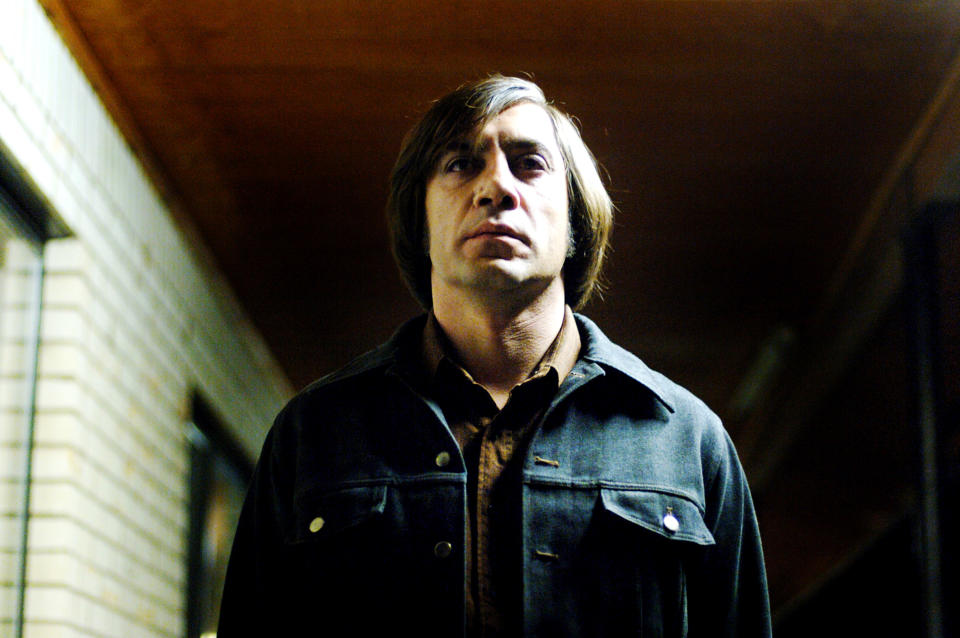
Season 3 begins with an East German interrogation of a man accused of murder because he lives in the same apartment as the killer. He insists he’s not the guy, doesn’t have a girlfriend, has a wife instead. “But you can’t argue with the state or the reality of it,” said Hawley. “I’m filming this in 2016. And Trump is elected, and we get into alternative facts. And because my grandmother had escaped from Kyiv in the 1800s from the Cossacks, I had this Cossack character and was this Russiagate? When the show aired, reality and fiction were unfolding at the same time. And people were like, ‘we don’t have the distance.'”
Sometimes you hit the zeitgeist just right. “And sometimes, you’re off,” Hawley said. “In that case, we were too early. In Season 4, we were a little too late, because we had been delayed. I had done this meditation on immigration and race in America. That George Floyd summer, a lot of shows wrestled with that. And we would have been at the front, if we’d been able to finish with COVID. But instead we were at the end. That’s the one thing you can’t control.”
For Season 5, Hawley went back to the source and hit it out of the park. “After 41 hours in ‘Fargo,’ I thought that I had earned the right to engage directly with the movie,” he said. “I wanted to revisit the movie ‘Fargo.’ I thought about playing a game of telephone, where a man sends two guys to kidnap his wife. And Joel and Ethan [Coen] told that story one way and I was going to tell it a different way. And in my version, the man was the ex-husband [Jon Hamm] she has run away from who was abusive.”
In the original “Fargo,” Bill Macy, Steve Buscemi, Harve Bushnell, and Peter Stomari play characters who are larger than life. Hawley decided to give equal weight to the story of the wife who gets a bag thrown over her head and dies. “I’d like to look at her journey,” he said, “and look at this idea of wifeness. And what we mean when we say ‘wife.'”
Casting British actress Juno Temple (“The Offer”) as the kidnapped mother Dot was not a play for eyeballs. “This is a woman who like many ‘Fargo’ characters lives in a state of denial,” said Hawley. “And the state of denial in ‘Fargo’ always endangers other people’s lives. It’s Kirsten Dunst in her state of denial that ends up with her husband getting killed because she can’t look at her own culpability. If I didn’t find an actress who was mischievous, who was fun, you would call Child Protective Services on her in five minutes. You’d think, ‘this is the worst mother of all time.'”
Again, Dot’s in a state of denial. “She’s putting up electrical wires on her windows,” said Hawley. “She’s allowing her child to be home when she knows these guys are going to come for her. But she’s such a positive can-do figure. She does not have a victim mentality. She’s just going to make it work. And if they won’t sell her a gun, you know she’ll do it with a Tiny Tim record and a strobe and the laundry chute. She’s just going to make it work. That’s part of what resonated for people.”

If Hawley was going to explore the idea of wife, he also needed to explore the idea of masculinity. If Dot’s first husband, Hamm as the out-of-control Sheriff, is the toxic alpha male, “I wanted to explore that that’s not the only way to be a man,” said Hawley. In opposition is Dot’s sweet husband Wayne (David Rysdahl). “He’s just a good guy. He has a powerful Mom, he has a powerful wife. He’s happy. He runs his own car company. He’s perfectly happy to be that guy. He just wants to watch ‘Real Housewives’ and play floor hockey.”
One thing Hawley refused to do was have the soft-spoken beta male rise up and prove his manhood by conquering the domineering alpha male, he said: “It doesn’t have to be this cynical, chest thumping thing.”
One of the most satisfying scenes in the show is Dot’s face-off against Lorraine, her docile husband’s fierce businesswoman mother (Jennifer Jason Leigh). “There’s a mask that [Dot] is wearing,” said Hawley. “The mask is who she really wants to be. The mask is not to cover up her true self, she really wants to be a good person, a good mom. But she’s prepared to defend what she has. She does something that no one ever does, which is surprise Lorraine. And blow her back.”
Leigh is a Coens veteran (“The Hudsucker Proxy”) who loves to deploy broad accents. For wealthy power-monger Lorraine, Hawley told her to think of arch-conservative William F. Buckley, “that sort of withering disdain,” he said. “I wasn’t saying to sound like William F. Buckley. On the first day of production, she showed up and William Buckley came out. I worked with her a little bit on toning it down to a place where it felt more like an affect and not like a performance. It’s [Lorraine’s] way of laundering herself: she doesn’t come from money. She’s self-made, too. Jennifer was doing in “Hudsucker’ this Mid-Atlantic 1940s Rosalind Russell thing, and William Buckley is that on Valium, slowed way down.”
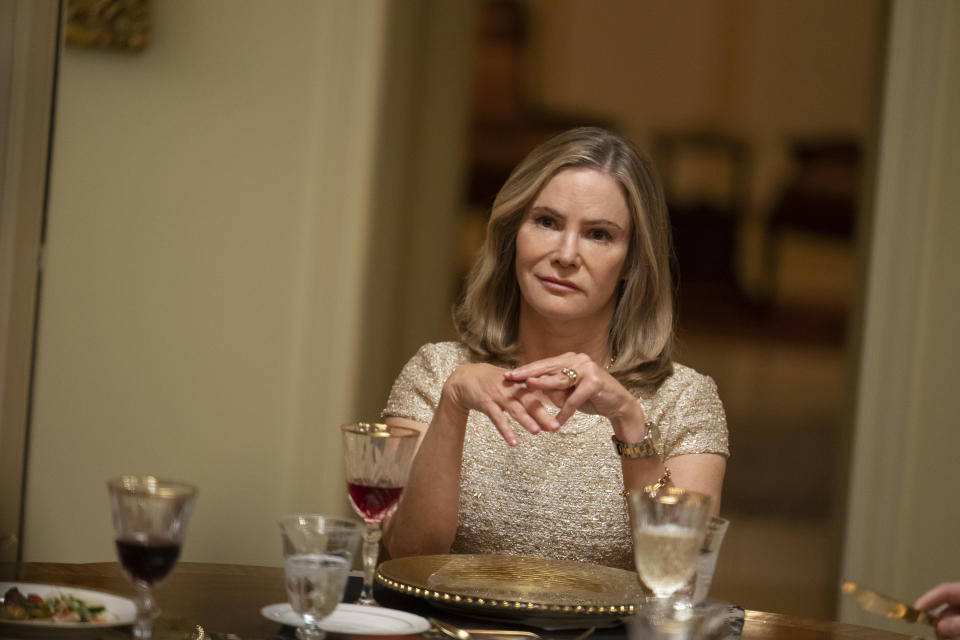
Lorraine isn’t Dot’s real problem. Enemy Number One is her Bible-thumping ex-husband Sheriff Roy Tillman (Hamm), who wants her back in his clutches so he can beat her at will. “He’s the Tiger King,” said Hawley. “It’s weird out there, man. It is a hedonistic, Trumpian, Tiger King world of morality and righteousness. In order to claim the moral high ground, you have to change what Jesus is. We went from benevolent turn-the-other-cheek Jesus to warrior Jesus to retribution Jesus. It’s a way to have your cake and eat it too. You don’t have to be this pious person, if you redefine what piety is. If you say that all this behavior is moral, then you can have a sex trunk in your bedroom. And you can have the nipple rings and still act like you can judge other people for their choices.”
Toward the end of the series, when Roy has chained Dot up in an abattoir for frequent battering sessions, Hawley stages a long single take of the recently humiliated Sheriff walking toward the camera, toward Dot, his rage seething. You know where he plans to direct his anger.
“It’s in the script,” said Hawley. “We stay with him the whole walk. I don’t want to let him off the hook. I want us to live with his face and to see what it takes to get a man to go and do this brutal thing. And he walks all this distance. And I had to go to artist Lisa Hannigan to record a cover of ‘Toxic’ by Britney Spears. We did this funeral dirge version of it. And then he goes inside, and the camera stays outside. And then he beats her. And we hear it, but we don’t see it because you know what’s happening in there. And then we cut inside and he leans down to tighten her cuff and she attacks him. When it’s abuse, you’re not seeing it. When it’s a fight, you’re seeing it.”
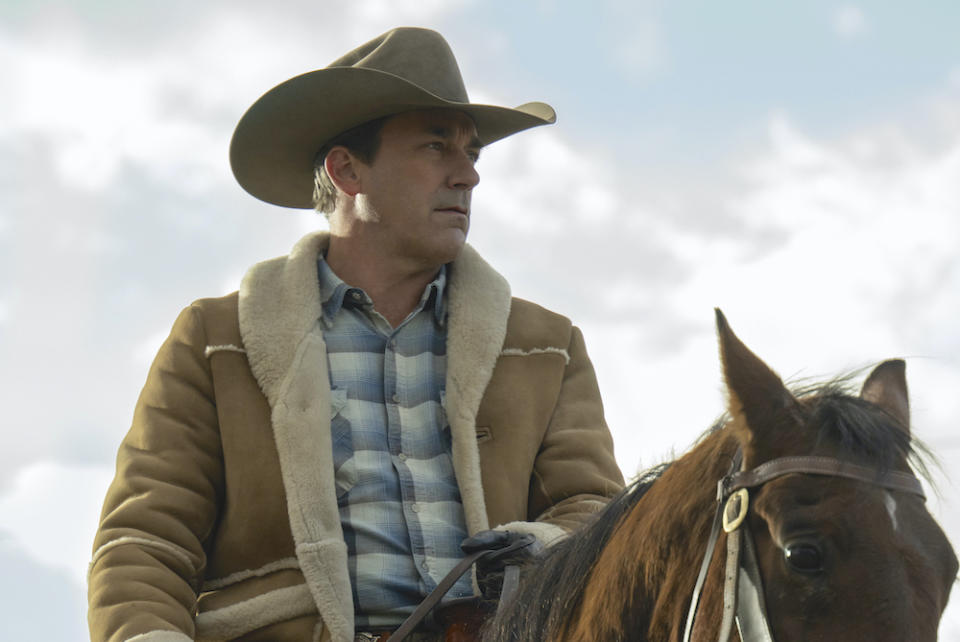
And who are the two big guys Roy sends to capture Dot? One is his hapless son Gator (Joe Keery), the other is strange-looking Ole Munch (Sam Spruell), a sin-eater from the old country who never dies. Hawley was inspired by a series of Margaret Atwood lectures on debt. “She talked about sin eating,” he said, “which was this old practice in which a rich man could pay some pauper a couple of coins to eat food off the corpse, maybe drink wine that you’d breathed on, and in doing so they took on your sins so that you could go to heaven. I thought, ‘This is humanity at its most base, right? Capitalism at its worst.’ But [Ole Munch] had sold his soul and as a result was forced to wander the earth in perpetuity afterwards. He sold his soul, there’s no ‘me’ left.”
Hawley hired Spruell because even when he was playing a racist cop in “Small Axe: Mangrove,” “he always looked like he wanted to cry a little bit,” he said. “There was a vulnerability to him. That’s what I wanted. I never wanted it to be simple for the audience to go, ‘Well, I hate that guy. That guy’s not even a human.'”
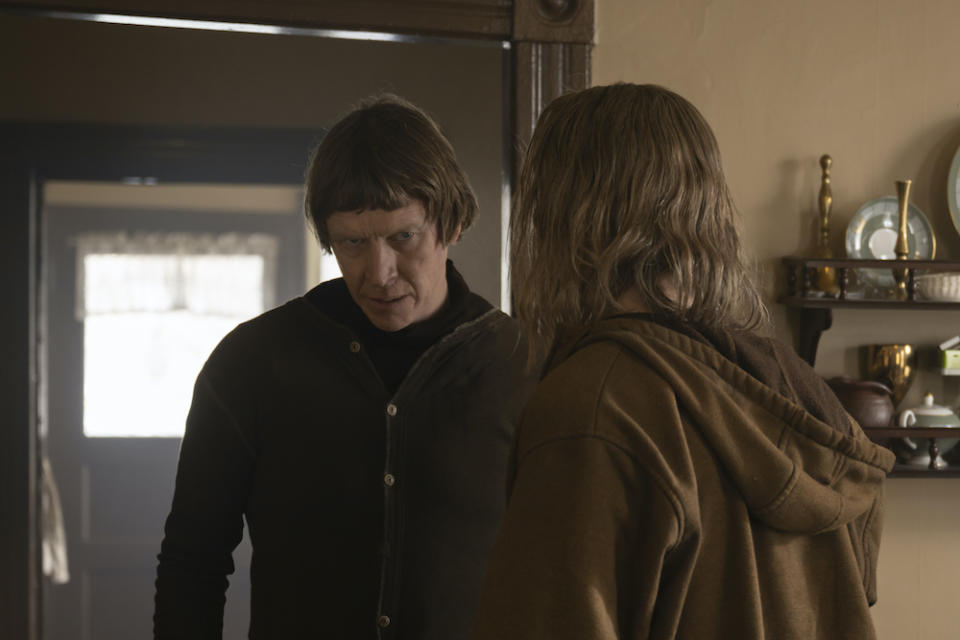
Hawley has toyed with the supernatural in past series. “The Coens are always flirting with it on some level,” he said, “whether it’s the lone biker of the apocalypse in ‘Raising Arizona,’ or the dybbuk in the beginning of ‘A Serious Man.’ There’s a UFO in ‘The Man Who Wasn’t There.’ And there’s the scene in ‘No Country for Old Men,’ after Josh Brolin’s character is killed and Tommy Lee Jones goes back to the motel. He’s standing outside the door, and he sees the lock has been punched out. And then you see how the rubber dam is on the other side of the door. He’s in the room, right? And there’s this long back and forth. And then when he opens the door, the room is empty. And so you go, ‘Was he there? And vanished? Or was he the fear in Tommy Lee Jones’ mind?'”
That’s why in the first episode of “Fargo” Season 1, when Billy Bob Thornton is in Martin Freeman’s character’s house and shoots the sheriff and goes down to the basement, followed by Freeman and the cops, when he disappears, Hawley ignored MGM’s note that he should show an open window. “How did he get out of the basement?” he said. “Exactly. How did he get out of the basement? So we started there.”
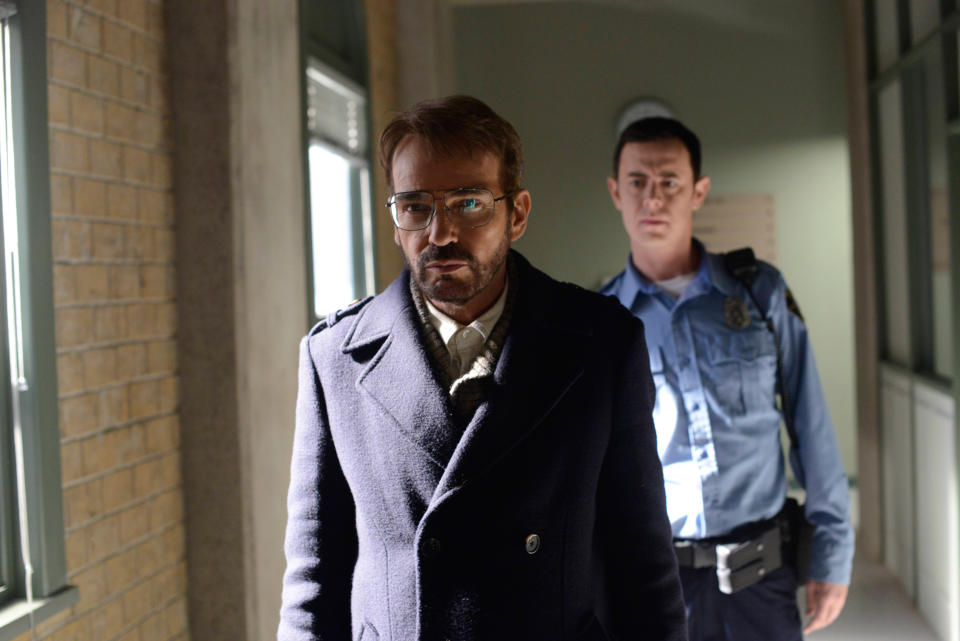
Season 2 had a UFO. And in Season 3, Hawley brought in a cosmic bowling alley that Mary Winston’s character ends up in. “I knew that there wasn’t going to be literal justice in that season,” said Hawley. “So I wanted the sense of cosmic justice: ‘Just you wait, it all gets sorted out.’ And then in Season Four, we had a ghost in the show.”
Next up: Hawley is open to returning to “Fargo.” “I’m game. I’m game to do it,” he said. But first he has to deliver to FX the latest iteration of the “Alien” franchise, a prequel set in the same universe as the first two films, but with none of the original characters. “We’ve shot about half, three quarters of it. And we’re going to wrap up in mid-July on this first year, which is eight episodes.” The scale is massive, and so is the cast led by Sydney Chandler, with Timothy Olyphant in a supporting role, 13 soundstages in Bangkok, plus VFX and practical effects.
After his long relationship with FX’s John Landgraf, which yielded Marvel series “Legion” as well as “Fargo,” when asked, Hawley came up with an idea for “Alien.” “Then a long time passed, because Emma Watts was running Twentieth Century Film at the time. She was like, ‘Get your hands off my ‘Alien’! It wasn’t until Iger came in that Disney was not going to be making the $100-million R-rated movie. So I blew the dust off and we got into it and started talking with Ridley [Scott].”
Best of IndieWire
2023 Emmy Predictions: Who Will Win at the Primetime Emmy Awards?
2023 Emmy Predictions: Outstanding Documentary or Nonfiction Special
2023 Emmy Predictions: Outstanding Documentary or Nonfiction Series
Sign up for Indiewire's Newsletter. For the latest news, follow us on Facebook, Twitter, and Instagram.

 Yahoo News
Yahoo News 
